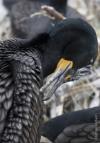 Benefits to Salmonids from Reductions in Predation by East Sand Island Double-crested Cormorants
Benefits to Salmonids from Reductions in Predation by East Sand Island Double-crested Cormorants
Predation on juvenile salmonids (Oncorhynchus spp.) during out-migration to the Pacific Ocean is considered a factor potentially limiting the recovery of anadromous salmonid populations from the Columbia River basin that are listed under the U.S. Endangered Species Act. We examined the potential benefits of reductions in predation by double-crested cormorants nesting at the large colony on East Sand Island (rkm 8) in the Columbia River estuary to three distinct population segments (DPSs) of steelhead (O. mykiss), four evolutionarily significant units (ESUs) of Chinook salmon (O. tshawytscha), and one ESU of sockeye salmon (O. nerka), all primarily originating from above Bonneville Dam (rkm 235). The East Sand Island double-crested cormorant colony, ca. 12,600 pairs during 2007 – 2010, is the largest colony for this species in western North America, and cormorants from this colony have been documented to consume millions of smolts per year.
Using predation rate data based on recoveries of smolt passive integrated transponder (PIT) tags on the East Sand Island colony and the framework of a simple deterministic, age-structured, matrix population growth model for salmonid populations, we translated potential changes in smolt survival due to reductions in cormorant predation into increases in the average annual population growth rate (lambda) at the level of the salmonid DPS/ESU. Estimates were produced for a range of reductions in cormorant predation and for a range in levels of compensatory mortality for smolts.
Potential increases in change in lambda for complete elimination of predation by East Sand Island double-crested cormorants, assuming no other mortality factors would compensate for this reduction in predation, ranged from 0.6 – 1.2% for Chinook salmon ESUs originating above Bonneville Dam, was 1.6% for the Snake River sockeye salmon ESU, and ranged from 1.9 – 2.5% for steelhead DPSs originating above Bonneville Dam. If a moderate level of compensatory smolt mortality (e.g., 50%) occurred in response to a complete elimination of cormorant predation, change in lambda values would drop below 1% for Chinook and sockeye salmon ESUs, but remain 1% or greater for steelhead DPSs.
In general, a two-thirds reduction in predation by double-crested cormorants nesting at the East Sand Island colony would produce similar levels of benefit for salmonids originating above Bonneville Dam to benefits projected for the ongoing management to reduce by two-thirds the predation by Caspian terns nesting at the East Sand Island colony (USFWS 2005). Management to reduce cormorant predation would not be as efficient, however, as Caspian tern management in terms of benefits per managed bird due to the lower per capita impacts of cormorants on survival of salmonids originating from above Bonneville Dam.
As seen with other analyses of avian predation, potential benefits to ESA-listed DPSs/ESUs of Columbia Basin salmonids from reductions in predation by East Sand Island double-crested cormorants are smaller than the total expected benefits projected from all recovery actions included in the proposed management of the Federal Columbia River Power System (FCRPS). Benefits from cormorant management would not ensure recovery of any of the eight ESA-listed salmonid populations we analyzed, but are comparable to other individual recovery actions included in the 2008 Biological Opinion on the management of the FCRPS.
The robustness of these analyses would be strengthened by additional information on (1) the degree to which other smolt mortality factors may compensate for reductions in mortality from cormorant predation, (2) the off-colony deposition rate of PIT tags from PIT-tagged salmonids consumed by cormorants, and (3) the impacts of cormorant predation on survival of ESA-listed salmonids from populations originating primarily below Bonneville Dam.
- Bird Research Northwest
Click here to view the complete report



